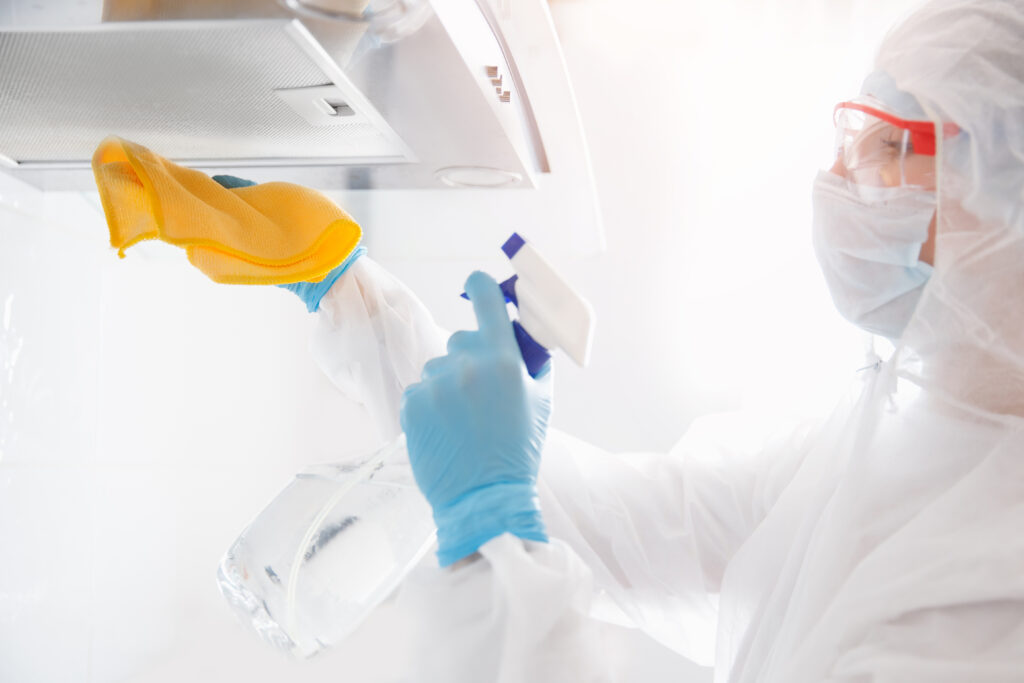The first time I cleaned a medical office, I thought I knew what I was doing. Twenty years of commercial cleaning experience, right? Then Dr. Patterson walked in, took one look at my work, and asked, “Did you high-level disinfect the examination table?”
High-level what now?
That was eight years ago. Now I run a cleaning service that specializes in medical facilities, and I cringe remembering how clueless I was. Turns out, cleaning a doctor’s office has about as much in common with cleaning a regular office as a bicycle does with a Boeing 747.
Why Your Regular Cleaner Isn’t Enough
My wake-up call came when one of my regular commercial clients, a dentist, got flagged during a health department inspection. Nothing major—just some protocol violations. But watching him sweat through that inspection made me realize I’d been playing with fire.

Disinfection Of Viruses And Germs In The Medical Office
“It’s not just about things looking clean,” the inspector explained to both of us. “It’s about preventing disease transmission. That requires specific products, specific techniques, specific training.”
She was right. The shiny floors and streak-free windows that impressed my office clients meant nothing if I was spreading MRSA from room to room with my regular mop.
The Bloodborne Pathogen Reality
Here’s what really separated medical from commercial cleaning: blood. Sounds obvious, but I hadn’t thought it through. Every surface in a medical office is potentially contaminated with bloodborne pathogens. That changes everything.
Regular office: Spray counter with all-purpose cleaner, wipe, move on.
Medical office: Pre-clean visible soil, apply EPA-registered hospital-grade disinfectant, maintain wet contact time (usually 1-10 minutes depending on product), then wipe.
That exam table? It needs intermediate-level disinfection between every patient. The blood pressure cuff? Same deal. Door handles get hit every hour, not just nightly.
My client Dr. Martinez showed me a culture they’d taken from an “clean” exam room. The petri dish looked like a science experiment gone wrong. “This is why we can’t use regular commercial cleaners,” she said.
OSHA Standards That’ll Make Your Head Spin
The regulations read like a foreign language at first. OSHA Bloodborne Pathogen Standard 29 CFR 1910.1030. CDC Guidelines for Environmental Infection Control. EPA List N disinfectants. My eyes glazed over studying for certification.
But then it clicked. This isn’t bureaucracy for bureaucracy’s sake. Every rule exists because someone got sick or died.
Take the color-coded system. Red mop for bathrooms, blue for patient areas, yellow for labs. Seems excessive until you realize you’re preventing C. diff from traveling from the bathroom to the procedure room. One mixed-up mop could shut down a practice.
The Invisible Dangers
Commercial cleaning is about what you can see. Medical cleaning is about what you can’t. That’s the fundamental difference that took me months to grasp.
A keyboard in a regular office might harbor some germs. A keyboard in a medical office could have traces of blood, saliva, or worse. Can’t tell by looking. That’s why everything gets treated as contaminated.
My team learned this the hard way when one of my cleaners got stuck by a hidden needle. She’d been cleaning regular offices for fifteen years, thought she knew to be careful. But medical waste is a different beast. Now we treat every trash bag like it contains sharps, even when it shouldn’t.
Terminal Cleaning vs. Daily Cleaning
Regular offices get one type of clean. Medical offices need multiple levels:
Daily cleaning: What happens every night. Disinfect high-touch surfaces, mop with hospital-grade disinfectant, empty trash according to biohazard protocols.
Terminal cleaning: The deep clean between patients in ORs or after a patient with infectious disease. Everything gets hit—walls, ceilings, inside cabinets.
We shut down Dr. Kumar’s procedure room for four hours for terminal cleaning after a patient with active TB. In a regular office, TB exposure might mean wiping down their desk. In medical, it means essentially stripping the room to its bones and disinfecting every square inch.
The Products Make All the Difference
Forget your Pinterest-friendly essential oil cleaners. Medical facilities need EPA-registered, hospital-grade disinfectants that kill specific pathogens. The labels read like chemistry textbooks.
We use quaternary ammonium compounds for daily cleaning—kills most bacteria and viruses with proper contact time. For terminal cleaning or known infectious cases, we break out the big guns: bleach solutions, hydrogen peroxide vaporizers, UV-C lights.
The cost difference is shocking. Regular all-purpose cleaner: $3 per gallon. Hospital-grade disinfectant: $25 per gallon. And you can’t dilute it wrong or it doesn’t work. We use test strips to verify concentration every single time.
Training That Never Ends
My commercial cleaning training was a day. Here’s the vacuum, here’s the mop bucket, don’t mix chemicals. Medical cleaning? Six weeks of initial training, annual recertification, ongoing education.
We practice proper PPE donning and doffing until it’s muscle memory. Learn which pathogens survive on surfaces and for how long. Study the difference between cleaning, sanitizing, and disinfecting (yes, they’re different).
The hardest part is breaking commercial cleaning habits. Spray-and-wipe doesn’t work when you need 60-second wet contact time. Using the same cloth for multiple surfaces is efficient in an office, deadly in a medical setting.
Real Stories From the Field
Last year, a pediatric office hired us after their previous cleaner—a regular commercial service—left visible blood on an exam table. A parent noticed and posted on social media. The practice lost a dozen patients that week.
Another client came to us after a norovirus outbreak traced back to improper cleaning. Twelve staff members and countless patients sick because the cleaning crew didn’t understand contact time for norovirus requires a different disinfectant.
But my scariest wake-up call? Finding out a dermatology office I’d cleaned for months did minor surgical procedures. I’d been treating their procedure room like a regular exam room. Thank God nothing happened, but I couldn’t sleep for a week thinking about what could have.
The Liability You Don’t See Coming
Commercial cleaning insurance: $2 million policy costs about $1,200 annually. Medical cleaning insurance: Same coverage costs $4,500. Insurance companies know the stakes.
One missed pathogen, one improperly cleaned surgical instrument (yes, some medical cleaners handle that), one healthcare-associated infection traced to your cleaning—you’re looking at lawsuits that make slip-and-fall cases look like pocket change.
Making the Switch
If you’re a medical office using regular commercial cleaners, stop. Today. It’s not about them being bad at their job—they’re just doing the wrong job. It’s like asking your mechanic to perform surgery. Different skillsets entirely.
Look for companies certified in healthcare environmental services. Ask about their training programs, their products, their protocols. If they can’t explain the difference between intermediate and high-level disinfection, keep looking.
Yes, it costs more. Our medical cleaning rates are 40% higher than commercial. But compared to one healthcare-associated infection, one failed inspection, one lawsuit? It’s nothing.
The Future of Medical Cleaning
COVID changed everything. Practices that used to be okay with “good enough” now demand hospital-level protocols. Patients ask about cleaning procedures. They want to see the certificates, know the products, understand the process.
We’re investing in new technology—electrostatic sprayers, UV-C robots, antimicrobial surface coatings. Not because they’re cool (though they are), but because pathogens evolve and so must we.
The days of medical offices making do with whoever cleans the insurance office next door are over. Healthcare-associated infections kill more people than car accidents. That’s not hyperbole—that’s CDC data.
Every surface we clean, every protocol we follow, every product we use is about preventing someone’s grandmother from catching something deadly during a routine checkup. When you frame it that way, those complex regulations start making perfect sense.
Medical cleaning isn’t just commercial cleaning with stricter rules. It’s a completely different profession with life-or-death stakes. Once you understand that, you never look at an exam table the same way again.

